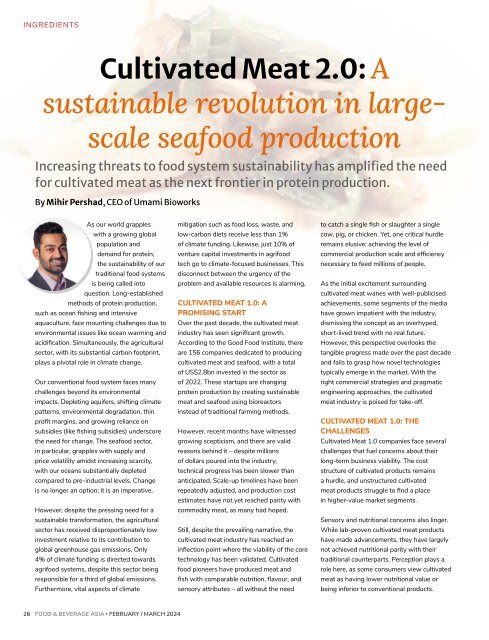Food & Beverage Asia February/March 2024
Food & Beverage Asia (FBA) is the leading source of food and beverage news in Asia since 2002. FBA delivers a comprehensive view of the food and beverage landscape, spanning across the latest health and nutrition trends and industry innovations in ingredients, recipe formulations, food science, sustainability, packaging, and automation, as well as advancements in agri and food-tech.
Food & Beverage Asia (FBA) is the leading source of food and beverage news in Asia since 2002. FBA delivers a comprehensive view of the food and beverage landscape, spanning across the latest health and nutrition trends and industry innovations in ingredients, recipe formulations, food science, sustainability, packaging, and automation, as well as advancements in agri and food-tech.
Create successful ePaper yourself
Turn your PDF publications into a flip-book with our unique Google optimized e-Paper software.
INGREDIENTS<br />
Cultivated Meat 2.0: A<br />
sustainable revolution in largescale<br />
seafood production<br />
Increasing threats to food system sustainability has amplified the need<br />
for cultivated meat as the next frontier in protein production.<br />
By Mihir Pershad, CEO of Umami Bioworks<br />
As our world grapples<br />
with a growing global<br />
population and<br />
demand for protein,<br />
the sustainability of our<br />
traditional food systems<br />
is being called into<br />
question. Long-established<br />
methods of protein production,<br />
such as ocean fishing and intensive<br />
aquaculture, face mounting challenges due to<br />
environmental issues like ocean warming and<br />
acidification. Simultaneously, the agricultural<br />
sector, with its substantial carbon footprint,<br />
plays a pivotal role in climate change.<br />
Our conventional food system faces many<br />
challenges beyond its environmental<br />
impacts. Depleting aquifers, shifting climate<br />
patterns, environmental degradation, thin<br />
profit margins, and growing reliance on<br />
subsidies (like fishing subsidies) underscore<br />
the need for change. The seafood sector,<br />
in particular, grapples with supply and<br />
price volatility amidst increasing scarcity,<br />
with our oceans substantially depleted<br />
compared to pre-industrial levels. Change<br />
is no longer an option; it is an imperative.<br />
However, despite the pressing need for a<br />
sustainable transformation, the agricultural<br />
sector has received disproportionately low<br />
investment relative to its contribution to<br />
global greenhouse gas emissions. Only<br />
4% of climate funding is directed towards<br />
agrifood systems, despite this sector being<br />
responsible for a third of global emissions.<br />
Furthermore, vital aspects of climate<br />
mitigation such as food loss, waste, and<br />
low-carbon diets receive less than 1%<br />
of climate funding. Likewise, just 10% of<br />
venture capital investments in agrifood<br />
tech go to climate-focused businesses. This<br />
disconnect between the urgency of the<br />
problem and available resources is alarming.<br />
CULTIVATED MEAT 1.0: A<br />
PROMISING START<br />
Over the past decade, the cultivated meat<br />
industry has seen significant growth.<br />
According to the Good <strong>Food</strong> Institute, there<br />
are 156 companies dedicated to producing<br />
cultivated meat and seafood, with a total<br />
of US$2.8bn invested in the sector as<br />
of 2022. These startups are changing<br />
protein production by creating sustainable<br />
meat and seafood using bioreactors<br />
instead of traditional farming methods.<br />
However, recent months have witnessed<br />
growing scepticism, and there are valid<br />
reasons behind it – despite millions<br />
of dollars poured into the industry,<br />
technical progress has been slower than<br />
anticipated. Scale-up timelines have been<br />
repeatedly adjusted, and production cost<br />
estimates have not yet reached parity with<br />
commodity meat, as many had hoped.<br />
Still, despite the prevailing narrative, the<br />
cultivated meat industry has reached an<br />
inflection point where the viability of the core<br />
technology has been validated. Cultivated<br />
food pioneers have produced meat and<br />
fish with comparable nutrition, flavour, and<br />
sensory attributes – all without the need<br />
to catch a single fish or slaughter a single<br />
cow, pig, or chicken. Yet, one critical hurdle<br />
remains elusive: achieving the level of<br />
commercial production scale and efficiency<br />
necessary to feed millions of people.<br />
As the initial excitement surrounding<br />
cultivated meat wanes with well-publicised<br />
achievements, some segments of the media<br />
have grown impatient with the industry,<br />
dismissing the concept as an overhyped,<br />
short-lived trend with no real future.<br />
However, this perspective overlooks the<br />
tangible progress made over the past decade<br />
and fails to grasp how novel technologies<br />
typically emerge in the market. With the<br />
right commercial strategies and pragmatic<br />
engineering approaches, the cultivated<br />
meat industry is poised for take-off.<br />
CULTIVATED MEAT 1.0: THE<br />
CHALLENGES<br />
Cultivated Meat 1.0 companies face several<br />
challenges that fuel concerns about their<br />
long-term business viability. The cost<br />
structure of cultivated products remains<br />
a hurdle, and unstructured cultivated<br />
meat products struggle to find a place<br />
in higher-value market segments.<br />
Sensory and nutritional concerns also linger.<br />
While lab-proven cultivated meat products<br />
have made advancements, they have largely<br />
not achieved nutritional parity with their<br />
traditional counterparts. Perception plays a<br />
role here, as some consumers view cultivated<br />
meat as having lower nutritional value or<br />
being inferior to conventional products.<br />
26 FOOD & BEVERAGE ASIA • FEBRUARY / MARCH <strong>2024</strong>

















